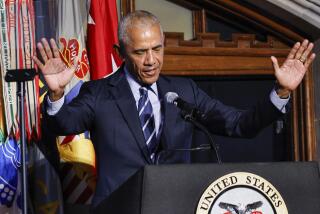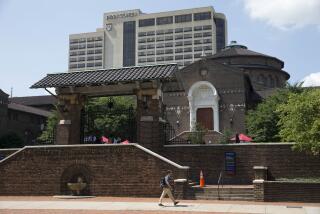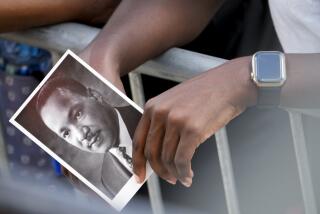Obama rides through history on Pennsylvania Avenue
- Share via
WASHINGTON — When Barack Obama takes his triumphant ride up Pennsylvania Avenue on Tuesday, he will retrace the path of Ku Klux Klan marches and roll past the ghosts of hotels and movie theaters that used to turn away people like him.
This historic stretch, bookended by the Capitol on one end and the White House on the other, has witnessed many of the milestones that made an Obama presidency possible. The Emancipation Proclamation and the Civil Rights Act of 1964 were signed here.
But it’s doubtful that even a Harvard-educated wonder can get his arms around the scope of the civil-rights drama that has played out on this 1.2-mile slice of real estate.
There are places more infamous for their scars -- Selma, Birmingham -- but none captures the sweep of the story the way Pennsylvania Avenue does, where laws were passed to enslave people and laws were passed to free them, and at least a dozen of Obama’s predecessors would sooner have considered him a piece of property than a peer.
Nearly every president has made this ceremonial trek since Thomas Jefferson did it on horseback. But never has the setting been as connected to the nation’s shame as much as its glory.
“That juxtaposition is the way I always think of Pennsylvania Avenue -- a place of great possibility and of great evil,” said Lonnie Bunch, director of the National Museum of African American History and Culture. “It is a mirror of change in America.”
Obama and his family will lunch with congressional luminaries and ride up the promenade in an armored 2009 black Cadillac limo after he takes the oath of office on Capitol steps built by slaves.
At 3rd Street, the motorcade will pass what used to be the St. Charles Hotel, a popular stop in the early 1800s where slaves were kept in underground cells while their owners enjoyed the luxuries upstairs; reimbursement was guaranteed if any escaped.
“That hotel became a favorite of black patrons after the Civil War,” said Charles Cobb, an author and professor of Africana studies at Brown University.
At 4th Street, a block from the hotel that made sure no slave escaped, the new president will pass what used to be the American Colonization Society Hall, founded in 1816 to return emancipated blacks to Africa, an effort fueled in part by whites who believed there was no place in America for a free black community.
Tension between races was inescapable for a democracy founded on a contradiction -- 12 of the early presidents were slave holders, eight while in the White House.
From the start, the heart of the nation’s capital -- a broad avenue designed by Pierre L’Enfant that was a dusty mess until it became the town’s first paved street -- was a place of mixed signals. Some freed blacks operated successful businesses while their brethren continued to be sold off in chains.
While in the White House, Andrew Jackson kept 150 house and field slaves back on his Tennessee farm. It was under his nose one night in 1835, at 6th and Pennsylvania, that a white mob ransacked the Epicurean Eating House and tried to lynch its black owner, a man named Beverly Snow.
Today, just a few doors down, an elegant pink building with twin spires stands as a monument to the civil-rights struggle: The National Council of Negro Women headquarters, purchased with the help of Oprah Winfrey six years ago, is the only black-owned property on this famous stretch.
Inside, Dorothy Height, 96, a lifelong activist and president emeritus of the civil-rights advocacy group, keeps an office.
“No inaugurated president will leave the Capitol to go to his house without passing our house,” she likes to say. Known for her trademark hats -- one day last week it was dusty blue with a big rhinestone-studded bow -- she was preparing to attend a swearing-in ceremony she did not think she would live to see.
“Barack Obama presents a strong symbol of what we have achieved under the hardest conditions,” said Height, who won a scholarship to Barnard College as a young woman but was denied admission because of her skin color.
The symbolism is even bolder considering the building is steps from 7th and Pennsylvania, where a teeming market of slaves, penned up in filth and misery awaiting sale, was a lucrative enterprise.
Obama will be halfway to the White House when he passes it. There is little to mark that it even existed. But, according to Bunch, a visiting British writer once noted that the business going on in the Capitol was drowned out by the anguished wails of families being separated and sold.
“We forget, but slavery was so embedded into the American system, it shouldn’t be a surprise that slaves were traded within the shadow of the Capitol,” Bunch explained.
Slavery was outlawed by 1865, but the inequality persisted. Blacks were barred from jobs, hotel rooms, toilets and restaurant counters. Pennsylvania Avenue led the nation in a dance: Two steps forward, and one step back.
Franklin D. Roosevelt opened the war-industry jobs to blacks after he was threatened with a massive march on Washington. Woodrow Wilson segregated the federal workplace to appease his offended wife.
And somewhere along this street, a sailor named Sam Harmon, stationed in Virginia during World War II, was denied admittance to a movie theater when the clerk saw the hand that reached for the ticket was black. He walked the streets that night in tears.
“As you move into the ‘50s and ‘60s, Pennsylvania Avenue is reflective of a segregated America,” Cobb said. “Black people cooked in the restaurants that served the capital but couldn’t eat in them.”
For nearly 100 years after slavery was outlawed, Pennsylvania Avenue did little to advance justice. Then in 1964, Lyndon B. Johnson signed the landmark Civil Rights Act outlawing discrimination in hotels, restaurants and department stores. Martin Luther King Jr. stood over his shoulder at the White House.
Four years later, smoke could be seen rising from Pennsylvania at 7th Street when riots broke out as word reached black neighborhoods north of downtown that King had been assassinated.
At 10th Street, Obama will pass within a block of Ford’s Theater, where Abraham Lincoln was shot by actor and Confederate sympathizer John Wilkes Booth on April 14, 1865. As if in a flurry to honor his legacy, Congress would adopt the 13th, 14th and 15th amendments outlawing slavery, making former slaves citizens and giving black men the vote.
One result: Black businessman James Wormley opened the capital’s first integrated hotel at 15th and Pennsylvania, a block from the White House.
Obama’s ceremonial journey will end at the nation’s most famous address: 1600 Pennsylvania Ave. For decades, the windows offered a view of slaves servicing the elegant homes on Lafayette Square.
Today, in that same spot, record crowds will gather -- braving confounding security, epic bathroom lines and biting cold -- to watch Pennsylvania Avenue dance another step forward.
--
More to Read
Sign up for The Wild
We’ll help you find the best places to hike, bike and run, as well as the perfect silent spots for meditation and yoga.
You may occasionally receive promotional content from the Los Angeles Times.






